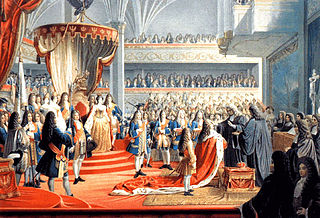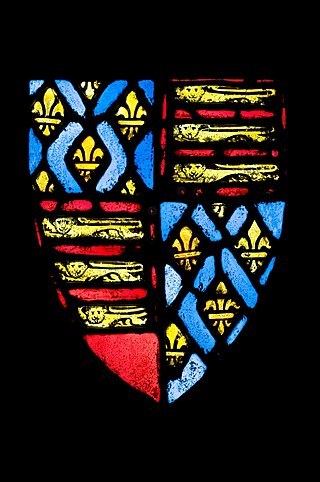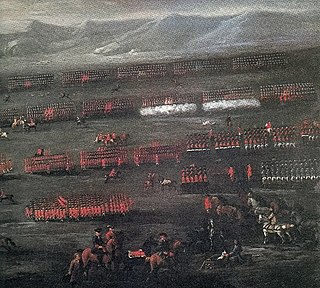Related Research Articles

1701 (MDCCI) was a common year starting on Saturday of the Gregorian calendar and a common year starting on Wednesday of the Julian calendar, the 1701st year of the Common Era (CE) and Anno Domini (AD) designations, the 701st year of the 2nd millennium, the 1st year of the 18th century, and the 2nd year of the 1700s decade. As of the start of 1701, the Gregorian calendar was 11 days ahead of the Julian calendar, which remained in localized use until 1923.
The Whigs were a political party in the Parliaments of England, Scotland, Ireland, Great Britain and the United Kingdom. Between the 1680s and the 1850s, the Whigs contested power with their rivals, the Tories. The Whigs became the Liberal Party when the faction merged with the Peelites and Radicals in the 1850s. Many Whigs left the Liberal Party in 1886 over the issue of Irish Home Rule to form the Liberal Unionist Party, which merged into the Conservative Party in 1912.

George I was King of Great Britain and Ireland from 1 August 1714 and ruler of the Electorate of Hanover within the Holy Roman Empire from 23 January 1698 until his death in 1727. He was the first British monarch of the House of Hanover.

James Francis Edward Stuart was the House of Stuart claimant to the thrones of England, Ireland and Scotland from 1701 until his death in 1766. The only son of James II of England and his second wife, Mary of Modena, he was Prince of Wales and heir until his Catholic father was deposed and exiled in the Glorious Revolution of 1688. His Protestant half-sister Mary II and her husband William III became co-monarchs. As a Catholic, he was subsequently excluded from the succession by the Act of Settlement 1701.

Mary of Modena was Queen of England, Scotland and Ireland as the second wife of James II and VII. A devout Roman Catholic, Mary married the widower James, who was then the younger brother and heir presumptive of Charles II. She was devoted to James and their children, two of whom survived to adulthood: the Jacobite claimant to the thrones, James Francis Edward, and Louisa Maria Teresa.
The Tories were a loosely organised political faction and later a political party, in the Parliaments of England, Scotland, Ireland, Great Britain and the United Kingdom. They first emerged during the 1679 Exclusion Crisis, when they opposed Whig efforts to exclude James, Duke of York from the succession on the grounds of his Catholicism. Despite their fervent opposition to state-sponsored Catholicism, Tories opposed his exclusion because of their belief that inheritance based on birth was the foundation of a stable society.

Succession to the British throne is determined by descent, sex, legitimacy, and religion. Under common law, the Crown is inherited by a sovereign's children or by a childless sovereign's nearest collateral line. The Bill of Rights 1689 and the Act of Settlement 1701 restrict succession to the throne to the legitimate Protestant descendants of Sophia of Hanover who are in "communion with the Church of England". Spouses of Catholics were disqualified from 1689 until the law was amended in 2015. Protestant descendants of those excluded for being Roman Catholics are eligible.

From the year 1340 to 1802, excluding two brief intervals in the 1360s and the 1420s, the kings and queens of England and Ireland also claimed the throne of France. The claim dates from Edward III, who claimed the French throne in 1340 as the sororal nephew of the last direct Capetian, Charles IV. Edward and his heirs fought the Hundred Years' War to enforce this claim, and were briefly successful in the 1420s under Henry V and Henry VI, but the House of Valois, a cadet branch of the Capetian dynasty, was ultimately victorious and retained control of France, except for Calais and the Channel Islands. Following the Hundred Years War, English and British monarchs continued to call themselves kings of France, and used the French fleur-de-lis as their coat of arms, quartering the arms of England in positions of secondary honour. This continued until 1802 when Britain recognised the French Republic and therefore the abolition of the French monarchy. The Jacobite claimants, however, did not explicitly relinquish the claim.

The Treaty of Union is the name usually now given to the treaty which led to the creation of the new state of Great Britain. The treaty united the Kingdom of England and the Kingdom of Scotland to be "United into One Kingdom by the Name of Great Britain". At the time it was more often referred to as the Articles of Union.

James II and VII was King of England and Ireland as James II and King of Scotland as James VII from the death of his elder brother, Charles II, on 6 February 1685, until he was deposed in the 1688 Glorious Revolution. The last Catholic monarch of England, Scotland, and Ireland, his reign is now remembered primarily for conflicts over religion. However, it also involved struggles over the principles of absolutism and divine right of kings, with his deposition ending a century of political and civil strife by confirming the primacy of the English Parliament over the Crown.
Events from the year 1766 in Great Britain.
Events from the year 1764 in Great Britain.
Events from the year 1762 in Great Britain.
Events from the year 1763 in Great Britain.
Events from the year 1782 in Great Britain. The American Revolutionary War draws to a close.
Events from the year 1717 in Great Britain.
Events from the year 1702 in the Kingdom of Scotland.
Events from the year 1701 in the Kingdom of Scotland.

The Jacobite rising of 1715 was the attempt by James Edward Stuart to regain the thrones of England, Ireland and Scotland for the exiled Stuarts.

The history of the monarchy of the United Kingdom and its evolution into a constitutional and ceremonial monarchy is a major theme in the historical development of the British constitution. The British monarchy traces its origins to the petty kingdoms of Anglo-Saxon England and early medieval Scotland, which consolidated into the kingdoms of England and Scotland by the 10th century. The Norman and Plantagenet dynasties expanded their authority throughout the British Isles, creating the Lordship of Ireland in 1177 and conquering Wales in 1283. In 1215, King John agreed to limit his own powers over his subjects according to the terms of Magna Carta. To gain the consent of the political community, English kings began summoning Parliaments to approve taxation and to enact statutes. Gradually, Parliament's authority expanded at the expense of royal power.
References
- ↑ Penguin Pocket On This Day. Penguin Reference Library. 2006. ISBN 0-14-102715-0.
- ↑ "Captain Kidd Lyrics". David Kidd.net. 23 July 2011. Archived from the original on 23 July 2011 – via Wayback Machine.
- 1 2 3 4 Williams, Hywel (2005). Cassell's Chronology of World History . London: Weidenfeld & Nicolson. ISBN 0-304-35730-8.
- ↑ "BBC History British History Timeline". Archived from the original on 9 September 2007. Retrieved 3 September 2007.
- ↑ "Q&A: Jews in Britain", BBC News, 13 June 2006, accessed 23 November 2010.